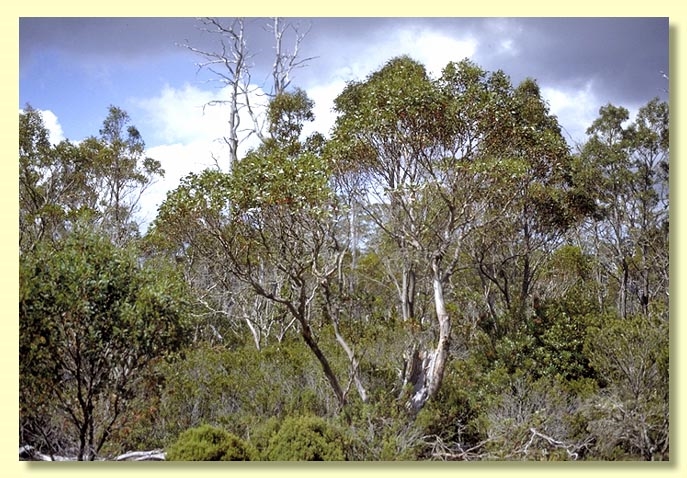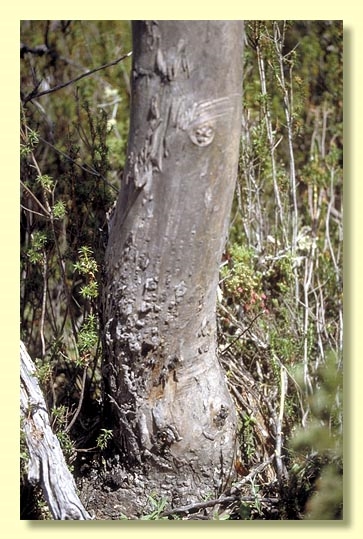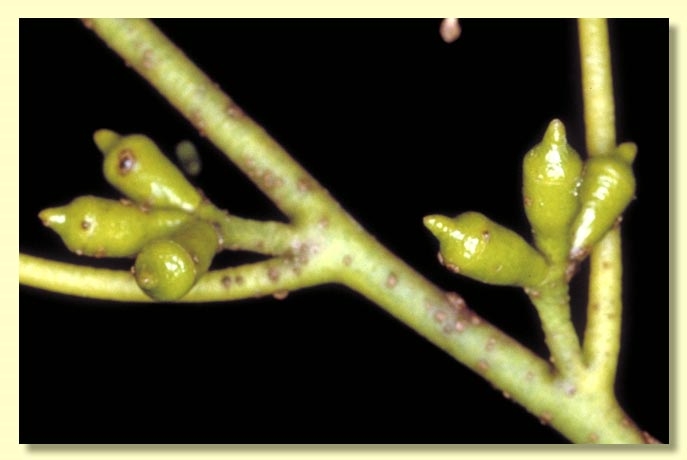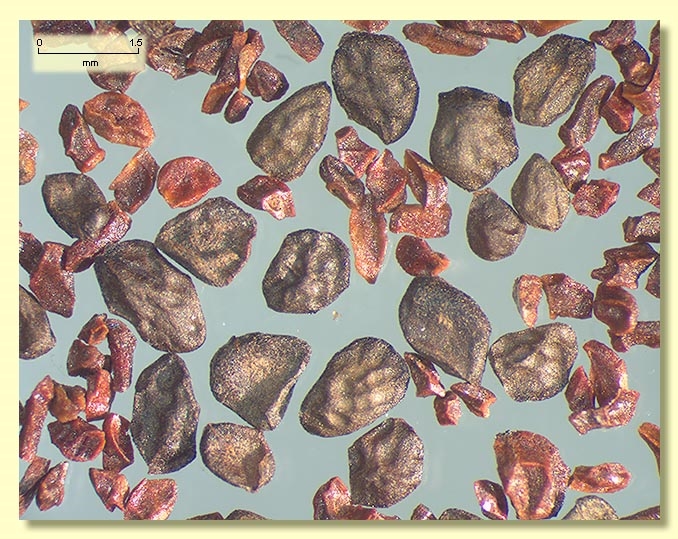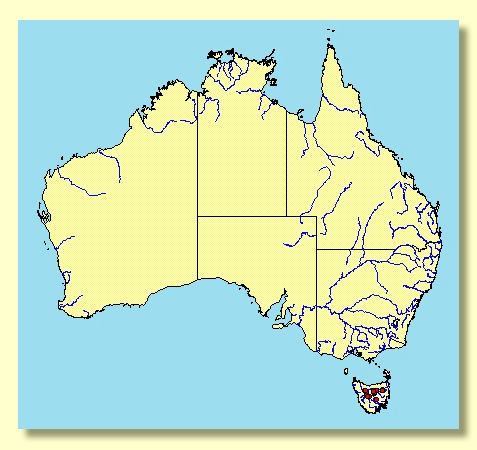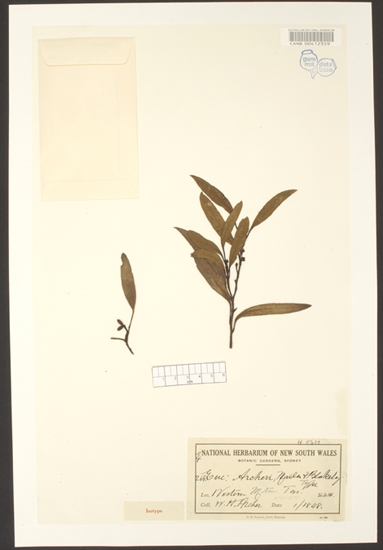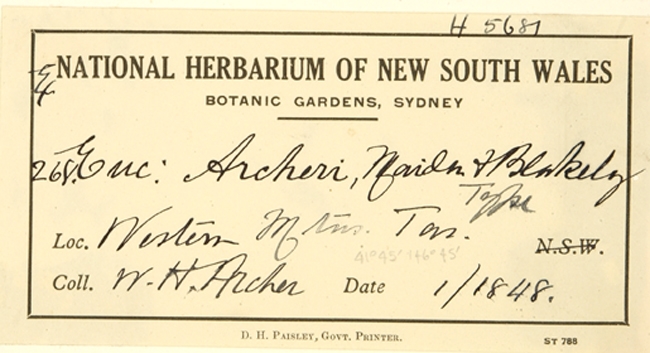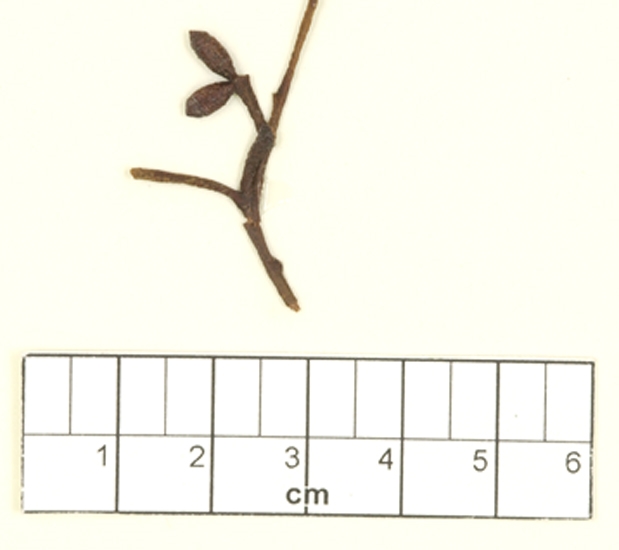Euclid - Online edition
Eucalyptus archeri
Eucalyptus | Symphyomyrtus | Maidenaria | Euryotae | Orbiculares
T: Western Mts, Tas., Jan. 1848, W.H.Archer; holo: NSW; iso: CANB.
Small tree or mallee to 12 m tall. Forming a lignotuber.
Bark smooth, grey-green, grey, pinkish, white or brown, sometimes with horizontal black scars.
Juvenile growth (coppice or field seedlings to 50 cm): stem rounded or square in cross-section, warty or smooth; juvenile leaves opposite, sessile and orbicular for at least 25 nodes, becoming alternate, petiolate, orbicular to ovate, 1.3–4 cm long, 0.9–3.2 cm wide, margin crenulate or entire, green or grey-green (only tip growth and newly expanded juvenile leaves glaucous).
Adult leaves alternate, petiole 0.8–2.2 cm long; blade lanceolate to elliptical, 4–9 cm long, 0.9–3 cm wide, flat (rarely undulate), base tapering evenly to petiole, margin entire, concolorous or slightly discolorous, glossy, green to grey-green, side-veins greater than 45° to midrib, densely to very densely reticulate, intramarginal vein parallel to and well removed from margin, oil glands scattered, intersectional.
Inflorescence axillary unbranched, peduncles 0.1–0.7 cm long, buds 3 per umbel, pedicels to 0.2 cm long or sessile (often only central bud pedicellate). Mature buds oblong to ovoid to obovoid, 0.5–0.7 cm long, 0.3–0.4 cm wide, green, usually slightly angular, scar present, operculum conical, rounded or slightly beaked, stamens inflexed, anthers cuboid to oblong, versatile, dorsifixed, dehiscing by longitudinal slits (non-confluent), style short or long, locules 3 or 4, the placentae each with 4 vertical ovule rows (sometimes with an incomplete fifth row). Flowers white.
Fruit sessile, barrel-shaped to obconical, 0.5–0.8 cm long, 0.5–0.8 cm wide, disc descending, valves 3 or 4, near rim level or enclosed.
Seeds dark brown or blackish, 1.2–2 mm long, ovoid or flattened-ovoid, often pointed at one end, usually lacunose, dorsal surface smooth or shallowly pitted, hilum ventral.
Cultivated seedlings (measured at ca node 10): cotyledons bilobed; stems usually square in cross-section, sometimes slightly winged, often slightly warty; leaves opposite and sessile for many nodes, orbicular to ovate, 1.5–2.7 cm long, 1.2–2.5 cm wide, base amplexicaul to rounded, apex rounded, glaucous weathering to green.
Flowering has been recorded in January, February, March, April, May, November and December with peak flowering in February and March (see Williams & Potts, 1996, p. 53).
A small tree or mallee endemic to north-central and north-eastern Tasmania where found on elevated poorly drained sites near rocky outcrops and escarpment edges, Eucalyptus archeri has smooth bark, glossy green to grey green crown leaves and buds in 3s and is non-glaucous.
It is distinguished from the closely related E. gunnii, which has glaucous buds and fruits. It is separated from other three-budded species in Tasmania by the combination of habit, habitat, lack of visible wax on the adult plant, obconical to barrel-shaped fruit and orbicular to ovate juvenile leaves < 4 cm long.
E. archeri belongs in Eucalyptus subgenus Symphyomyrtus section Maidenaria, a large group of species more or less restricted to south-eastern Australia, characterised by bilobed cotyledons, simple axillary inflorescences, buds with two opercula, stamens with versatile anthers and flattened seeds with a ventral hilum. Within this section, E. archeri, with nine other species, forms series Orbiculares having orbicular to cordate juvenile leaves opposite for many nodes, a grey-green to green crown, and buds in threes. Series Orbiculares is confined to far south-eastern New South Wales, eastern Victoria and Tasmania. The other species forming series Orbiculares are E. perriniana, E. glaucescens, E. saxatilis, E. urnigera, E. morrisbyi, E. gunnii, E. cordata, E. pulverulenta and E. chapmaniana.

